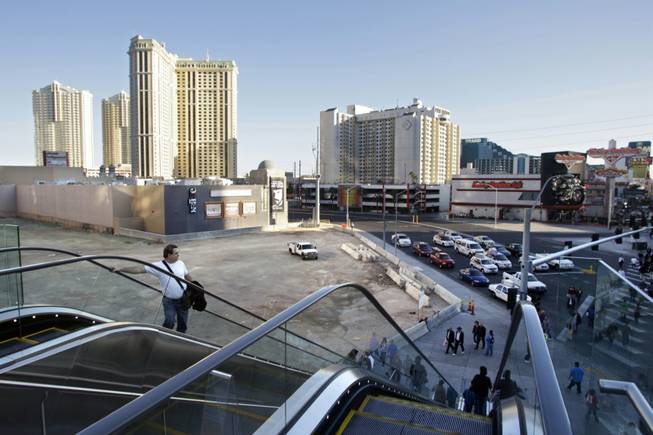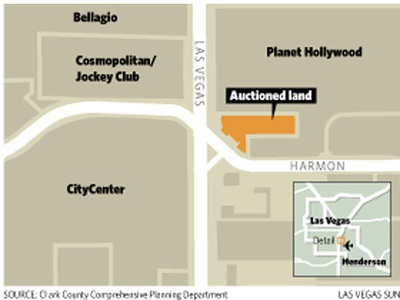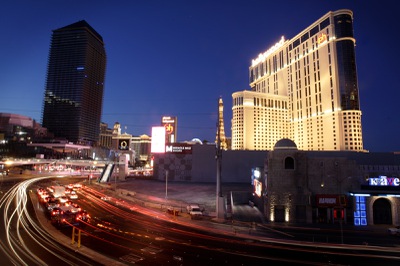
Last week’s sale of property fronting the Strip was the first such sale since November 2007.
Monday, Feb. 8, 2010 | 2 a.m.
Sun Archives
BIG DEALS
Major land sales along Las Vegas Boulevard, before and after the real estate bubble. Last week’s bid was the first official land sale since November 2007.
This list includes transactions recorded with the Clark County Assessor’s office and does not include land that was acquired by purchasing an entire company or company equity. Land prices on the list may not reflect previously-reported figures that were not taken from county records but from press releases or other unofficial sources.
- February 1998: Kansas businessman Phil Ruffin pays $142 million for the 25.5-acre New Frontier, or $5.6 million per acre. After scrapping various plans to develop a resort, he sells it to El Ad in 2007, near market peak.
- September 1998: Steve Wynn’s Mirage Resorts buys 11.3 acres at the northwest corner of Harmon Avenue and Las Vegas Boulevard for $118.8 million, or $10.5 million per acre, to assemble land adjacent to the former Boardwalk for a major resort.
- June 2000: Steve Wynn buys the 220-acre Desert Inn for $270 million, or $1.2 million per acre. He would eventually build Wynn Las Vegas and Encore resorts there.
- April 2003: Retail developers purchase the site of the former Rosewood Grille near the Venetian for $32.5 million and open a Walgreens, now surrounded by the Palazzo resort. The per-acre record price of $51 million (the site is .64 acres) stands.
- April 2004: Condo developers buy 5 acres at the northwest corner of Harmon Avenue and Las Vegas Boulevard for $90 million to build the Cosmopolitan. The recorded land transaction, calculated at $17.8 million per acre, doesn’t include additional land used to build the under-construction resort.
- July 2004: Developers buy 3.6 acres between the Sahara and Riviera for $26.2 million, or $7.3 million per acre, to build a high-rise condominium. Developers terminate the project for lack of sales, and buyers sue. Turnberry Associates buys out the company and starts Fontainebleau Las Vegas.
- September 2005: Centex buys the Westward Ho for $145.5 million, or $9.5 million per acre. Centex tears it down the casino but abandons plans to build a high-rise condo, instead transferring the land to a partner with plans for a casino.
- December 2005: Harrah’s Entertainment buys the Imperial Palace, surrounded by other Harrah’s-owned casinos, for $370 million, or $20.1 million per acre.
- October 2006: Harrah’s buys the former Westward Ho site for $279.9 million, or $18.4 million an acre. Harrah’s swaps the land for the Boyd Gaming-owned Barbary Coast. Boyd uses the Westward Ho site to expand its planned Echelon resort, now on hold, and Harrah’s adds the Barbary Coast, renamed Bill’s Gamblin’ Hall & Saloon, to its holdings.
- May 2007: MGM Mirage purchases 25.8 acres at the southwest corner of Las Vegas Boulevard and Sahara Avenue for $444.4 million, or $17.2 million per acre. Nearby, the company acquires another 7.6 acres for $131.6 million. Including the company’s adjacent Circus Circus property, it controls more than 100 acres for the purpose of building a resort complex similar to CityCenter.
- August 2007: SBE Entertainment and real estate investor Stockbridge Real Estate Funds buy the 17.5-acre Sahara for $345 million, or $19.7 million per acre.
- October 2007: Developer Triple Five purchases the 5.4-acre site of the now-dismantled La Concha motel for $180 million, or $33.1 million per acre.
Sources: Clark County Assessor, CB Richard Ellis
Sun Coverage
Vacant land on the Las Vegas Strip changed hands last week in the first such deal on the famed 4-mile corridor since the recession.
Surprised observers of the $25 million acquisition of 2.15 acres at Harmon Avenue and Las Vegas Boulevard by developer Brett Torino and two undisclosed partners had one key question: how to value Strip property in this — or any — economy? In this case, the property was purchased from Clark County in a land auction.
When business was brisk in Las Vegas, developers and speculators fought over Strip parcels. Casino executives were quoted declaring the land beneath their casinos was worth $20 million per acre. Those estimates inched upward during the boom years, topping out at more than $30 million per acre.
Now, in the worst economy in Las Vegas history, owners are fighting to pay down debt on that land and buyers are few and far between.
That complicates establishing the value of Strip land because comps — as the real estate types call the sales of nearby property used in setting prices — are scarce.
John Knott, executive vice president of CB Richard Ellis in Las Vegas, estimates that land prices on the Strip are down 90 percent from their peak. That’s even more dramatic than the drop in Clark County’s housing market, where prices for existing homes are down nearly 60 percent.
That decline is why locals are puzzled by the hefty price — $11.6 million an acre — Torino and his partners were willing to pay Clark County for the 2-plus-acre parcel on the northeast corner of Harmon and Las Vegas Boulevard. The land fronts the Strip and is adjacent to Planet Hollywood and across the street from CityCenter.
Grant Govertsen, a principal with casino consultants Union Gaming Group in Las Vegas, said it would be “highly unlikely” that a developer could acquire land for more than
$10 million per acre, build something and operate it profitably enough to cover interest payments.
Investors could sit on the land in the hope of flipping it to Planet Hollywood’s future owner, Strip casino giant Harrah’s Entertainment, Govertsen said.
Torino couldn’t be reached for comment on his plans for the land, which was appraised by the county at $24.7 million. Nobody else came forward to bid on it.
Knott said he was “shocked” by the price. Small parcels on the Strip are worth closer to $4 million per acre in today’s economy, maybe even less for bigger parcels that must justify larger, harder-to-finance projects, he said. “Everything’s worth less than what it costs to build and the condo market is dead. I just don’t know what kind of development plan would justify it.”
CB Richard Ellis is marketing a 4.8-acre parcel behind Walgreens on Convention Center Drive, near Las Vegas Boulevard, for a mere $20 million, or $4.2 million an acre.
During the boom, casino land was valued based on a belief that Strip property could only grow in value.
With Wall Street banks eager to invest in the Strip’s future and MGM Mirage’s CityCenter setting a new bar for megaresort construction, it seemed — at least for several months in 2006 and early 2007 — that land prices were but reflections of buyers’ active imaginations.
That was a departure from previous years, when casinos were valued more concretely, based on what they earned. Just as the real estate bubble turned homes into vehicles for quick profit, it transformed Strip-front land into parcels ripe for speculation. Even if half-baked resort plans didn’t pan out, investors could simply flip the land to someone willing to pay more. Finding interested buyers wasn’t difficult at a time when Strip resorts were breaking tourism and profit records.
Some buyers were private equity funds with money to burn and the ability to borrow vast sums. These equity funds, willing to bet more aggressively on the Strip than public companies with quarterly earnings statements to worry about, helped bid up land values in Las Vegas.
The results were spectacular.
Columbia Sussex paid $2.8 billion to acquire Aztar Corp., a 2006 deal that valued Aztar’s 34-acre Tropicana site on the Strip at roughly $30 million per acre.
The following year, privately held real estate developers El Ad paid $1.2 billion for the New Frontier, an aging casino that was imploded to make way for a casino resort version of the company’s famed Plaza Hotel in New York. The $34 million-per-acre price tag, for land that’s now gathering tumbleweeds, surprised even the most bullish casino executives.
Months later it was evident that the market, pressured by tighter lending requirements, falling home prices and later, plummeting consumer travel spending, had peaked. Redevelopment plans tied to both deals faltered.
Last week’s transaction was the first land sale on the Strip — excluding other types of deals like company purchases and land exchanges — since November 2007, county records show.
Meanwhile, Torino and other major owners of FX Real Estate & Entertainment have run into problems managing the debt on the company’s primary asset: 18 acres south of Harmon and Las Vegas Boulevard, just south of the parcel Torino is picking up from the county.
FX has planned for several years to develop a casino resort and entertainment complex on the land, now occupied by retail tenants including the Harley-Davidson Cafe, Hawaiian Marketplace and Smith & Wollensky.
Plans for an Elvis-themed resort dried up in the recession and the company, unable to pay a $475 million mortgage that came due in January 2009, is now on the brink of a bankruptcy that is expected to involve the sale of the land to repay lenders. (The company wrote down the value of the land to $140.8 million last year — $8 million per acre.)
Land prices are always a function of what buyers are willing to pay. That’s not easy to figure out on the Strip, where land doesn’t change hands that often.
No two Strip properties are alike. Each casino earns a different amount based on its marketing, location and customer base. Acreage at the north end of the Strip — a district known for its low-rent casinos — might be worth less than land at the center of the Strip, which attracts the majority of passers-by.
Land appraisers may have an even tougher challenge given a lack of buyers willing to consummate deals.
“Given the cost of development and the economic downturn you’re not likely to see hotel-casino projects developed anytime soon, and we haven’t seen a whole lot of land speculation taking place in the resort corridor or (the suburbs) because of the uncertainty that exists in the market,” said Brian Gordon, a principal with Applied Analysis in Las Vegas.
But Las Vegas — like anyplace else — has its bulls and bears, its cheerleaders and skeptics.
Torino — who was part of an investment group that bet big on the Riviera casino’s parent company in the hopes of potentially redeveloping the aging property — appears to be a true believer.
Sun reporter Joe Schoenmann contributed to this story.



Join the Discussion:
Check this out for a full explanation of our conversion to the LiveFyre commenting system and instructions on how to sign up for an account.
Full comments policy